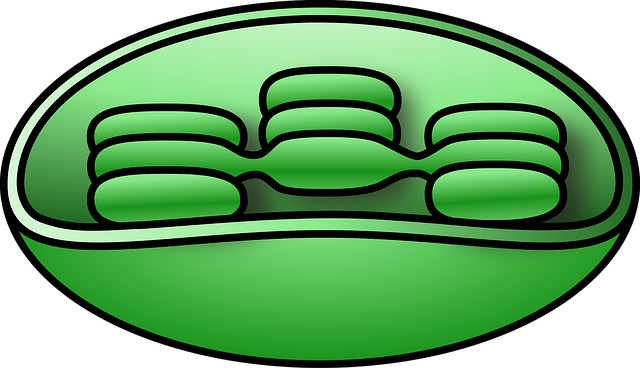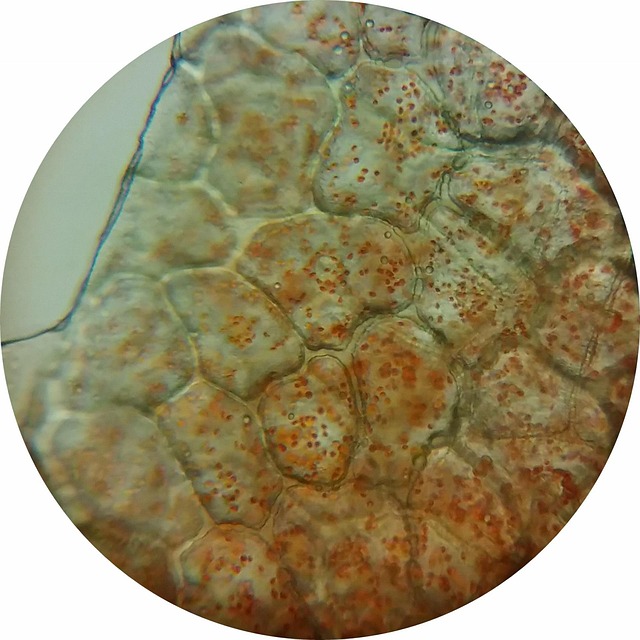
Photosynthesis: Making Energy
Chloroplasts -------> Find a picture of a Chloroplast, draw it, then label it. 

Photosynthesis is a process in which sunlight energy is used to make
glucose. The site of photosynthesis is in the chloroplast – an organelle
found in the leaves of green plants. The main functions of chloroplasts are
to produce food (glucose) during photosynthesis, and to store food
energy. Chloroplasts contain the pigment, chlorophyll. Chlorophyll absorbs
most of the colors in the color spectrum, and reflects only green and
yellow wavelengths of light. This is why we see leaves as green or yellow –
because these colors are reflected into our eyes.
1. What is photosynthesis? ______________________________________________________
_________________________________________________________________________
2. Where does photosynthesis occur? ______________________________________________
3. What are chloroplasts and where are they found? ___________________________________
_________________________________________________________________________
4. What are the two main functions of chloroplasts? ___________________________________
5. Why do most leaves appear green? _____________________________________________
6. What is the primary pigment found in the chloroplast? ________________________________
Photosynthesis
Glucose is another name for sugar. The molecular formula for glucose is C6H12O6. Plants make sugar by
using the energy from sunlight to transform CO2 from the air with water from the ground into glucose.
This process, called photosynthesis occurs in the chloroplast of the plant cell. During this process,
oxygen (O2) is created as a waste product and is released into the air for us to breath. The formula for
photosynthesis is:
(reactants) (products)
CO2 + H2O + sunlight ----> C6H12O6 + O2
This formula says that carbon dioxide + water molecules are combined with the energy from sunlight to
produce sugar and oxygen. The reactants in photosynthesis (what is used) are CO2, water and sun. The
plant gets water from the ground through its roots. The plant collects carbon dioxide from the air. Much
of the carbon dioxide comes from living organisms that exhale (breath it out) it, but some also comes
from factory smokestacks and car fumes.
7. What is the formula for photosynthesis? __________________________________________
8. What three things are used to make glucose in photosynthesis? _________________________
________________________________________
9. Where does the water come from? ______________________________________________
10. Where does the water enter the plant? ___________________________________________
11. Name 3 some sources of CO2. _________________________________________________
12. What type of energy does the plant use to convert CO2 and H2O into sugar? ________________
The products are glucose and oxygen. The glucose produced is used by the plant for energy and growth.
We also use this glucose by eating plants. The oxygen produced is released into the air for us to breath.
Photosynthesis is essential for all life on earth, because it provides food and oxygen. Plants are
considered autotrophs because unlike us humans, they can make their own food using this process.
13. What is produced in photosynthesis? _____________________________________________
14. What is the glucose used for? __________________________________________________
15. What is the oxygen used for? __________________________________________________
16. Here are three different ways to visualize the photosynthesis reaction: Is it easier for
you to understand the reaction by using pictures, words, or symbols (see above)? Why?
_____________________________________________________________________
Complete the bottom creating a chart.
Photosynthesis in pictures Photosynthesis in words Photosynthesis in symbols
Essential Question: Describe, using scientific terms, how plants turn sunlight into energy? Make
sure to refer to the chemical equation to photosynthesis and discus the reactants and products.Complete in your own works.
______________________________________________________________________________________
End Photosynthesis- Stop here.
Essential Question: How does ecology relate to the overall theme of biology?
November 17, 2015- Happy Friday- Remember Monday is a late start.
How Wolves Change Rivers- Watch the video and summarize if you were absent.
Tomorrow you will have a test on ecology.
Today you will work on a graphing assignment.
Due tomorrow at the beginning of class: Wolf/moose article, germination lab, ecology packet
- Go through and number the paragraphs.
- As you are reading underline any unfamiliar words.
- As you are reading circle any words that you have learned so far.
- As you are reading annotate what you read in the margins of the article. This can be as simple as several words emphasizing what is talked about.
- When done do a MELCON of the reading
Below is the assignment from Monday and Tuesday
Go to the website below for Monday's assignment. Click on the worksheet for the assignment but do not print it out. Write out the answers to the questions on your own paper using complete sentences.
Ecology Webquest - Click on the links on this page to answer the questions.
The link for prairie succession does not work so go to the link below and follow these alternate instructions.
Succession- Take notes on the first screen.
- Go through the primary and secondary successions screens following the instructions and draw what you see on the screen.
- Take the quiz and put the answers you gave.
October 13, 2015
Finish up Zombie assignment. Print a copy and share with Ms. Chabi
Make sure you get your grade reports signed!
Antibiotic Resistance Article- Focus on how this is an example of evolution.
1. Explain how antibiotics work.
2. Differentiate between the 2 main types of germs and which antibiotics target.
3. Discuss common mistakes patients make.
4. Describe what is said about doctors prescribing these drugs.
5. Summarize how this is an example of evolution and what you should do to prevent this happening to you. (This should be a paragraph.)
Homeostasis and Zombies assignment.
Through the wormhole video- Zombies
Worksheet for movie
Webquest - You and your partner have been hired by the CDC to save the world!
Begin by each person taking notes and making a chart like the one on the website.
READ the instructions!
The website is not working. You should have information on the following in relation to your system and homeostasis.
1. What is homeostasis and the 5 things that maintains it.
2. How your system works and how it maintains homeostasis.
3. Describe and have pictures for the functions and main organs of your system.
4. How you can survive a zombie attack by attacking someone via your organ system.
5. Suggestions to defeat zombies.
Evolution of Emerging Diseases- You have just been hired by the CDC
emerging infectious disease podcasts cdc
How does an infectious disease spread?
Influ-venn-za: Who can catch which flu?
__________________________________________________________
Bioengineering Webquest - This is something you will be working in groups of 3. You need to find at least 1 person you have not worked with for this project. The first 2 parts are individual though.
Watch how gm foods are made Use this instead of the one on the site.
On the Welcome page- Watch the 2 videos and summarize them.
On the Introduction page- Read through the questions because these are what you will be investigating for your project. Next on the bottom of the page. Go through the Explore: What's Coming for Dinner and explain what you did. Next do the lab.
You will not be allowed to pick your groups on Wednesday unless you have the above finished. I will be back on Wednesday to check this.
Human Genetics Disorder Project-
Make sure you read all the instructions!!
This you may do with a partner and it is your responsibility to make sure that someone else does not have the same topic as you. Points will be taken off if there are multiple presentations on the same topic. You may do a Prezi or Powerpoint and these will be presented to the class. Points will not be given until you present. If 1 person is absent for part of the project you will then do the project individually. This is meant to be collaborative so do not take turns doing the project. Each person should be working the whole time.
Email me with any questions at eduphile@gmail.com
Dawn of de-extinction
Book work: Read and take notes on pages 204-210 and then do the review questions on page 210, numbers 1-7,9,10.
Today is Darwin Day. Hopefully, you are done with your science fair documents becaue today you are to design a card using either Word or Google Docs to Charles Darwnin. Make sure you thank him for all he has done for science and the study of evolution. Below are some helpful sites for you to read. Put plenty of Darwin information and pictures on your card to him.
Darwin Day 2013: What you don't know about Charles Darwin
Video version of above article
International Darwin Day Foundation
Week of February 5, 2013
You should also have turned in the DNA note project we began in class. If you want to work on it because everything else is finished ask me to go get a book from class.
New: Your Environment, Your Epigenome. Record observations from your daily life and make an epigenomic diagnosis using the back of the page as to how well you are doing. If you forgot what the epigenome is then go here. Make sure you describe how epigenetics works.
Karyotyping Activity - Be the geneticist and follow the instructions.
PI: Pedigree Investigator - Answer all questions throughout and take notes on what you do.
Begin with What is Cloning?
Tomorrow we will be using the computers again and I will make that a catch up/ ask Chabi about science fair day. Use your time wisely!
Friday we will watch The Island. : )
____________________________________________________________
Cell Cycle, Mitosis and Meiosis Webquest Links.
Mitosis
Q's 1-2, 3, 4, 5, 6, 7, 8, 9-11, Online Root Tip and Qs 12-13,
Meiosis
Qs 1-10, 11-27 and Quiz, 28, 29
Here is a video on meiosis from Khan academy like the one we watched on mitosis.
Here is a video on embryonic stem cells.
And cancer.
November 16,2012
Mouse Party - Use this site to do the worksheet given to you.
Don't forget to finish The Magic Schoolbus Assignment and the 2 worksheets given to you.
October 24-25, 2012
Forks over Knives - Here is the website for the movie so you can check it out. It has a lot of information about good nutrition.
Your assignment is to think of 5 questions based on your notes to research. We will work on this both Wednesday and Thursday. Make sure you take notes answering your questions thoroughly and site your sources.
Make good use of your time.
October 16-18 th
Marvelous Molecule Madness - A Biochemistry Webquest
When you are finished then do this.
Research the following: High Fructose Corn Syrup, Saturated and unsaturated fats
Describe what they are and their relation to health. Are they healthy for you? Are there health concerns associated with them? Write a 1 page paper describing them , make sure you site your sources.
First week: SLANT, brain, and intro to bio
Brain song - Pinky and the Brain
- : )Brain awareness week
Article on Natural Selection in Humans.
Biomolecule Foldable Directions
2. Make 3 cuts up to the fold on one side of the paper to form 4 flaps.
3. Write the following on the flaps: Carbohydrate, Protein, Lipid, Nucleic Acid
4. Under each flap put the following information:
- Elements that make up molecule
- Functions of molecule
- Monomer or Building Block of molecule
- Sketch of molecule
- Examples of molecule
- Test(s) used to detect molecule
- Start with The Inside Story of Cell Communication- Take notes on what you learn.
- Go to the fight or flight response. Watch it a and summarize what you learn. Make sure you explore the learn more section right below.
- Now go to When cell communication goes wrong and explore ideas for your worksheet which is on my desk.
You should have finished your Build-A-Membrane activity with notes on what the heck it is. After that notes on cell reproduction (my-toeses and binary fission) pages 154-160. Your notes should have pictures. On page 160 answer questions 1-3 on stem cells. : )
Remember extra credit! Fun